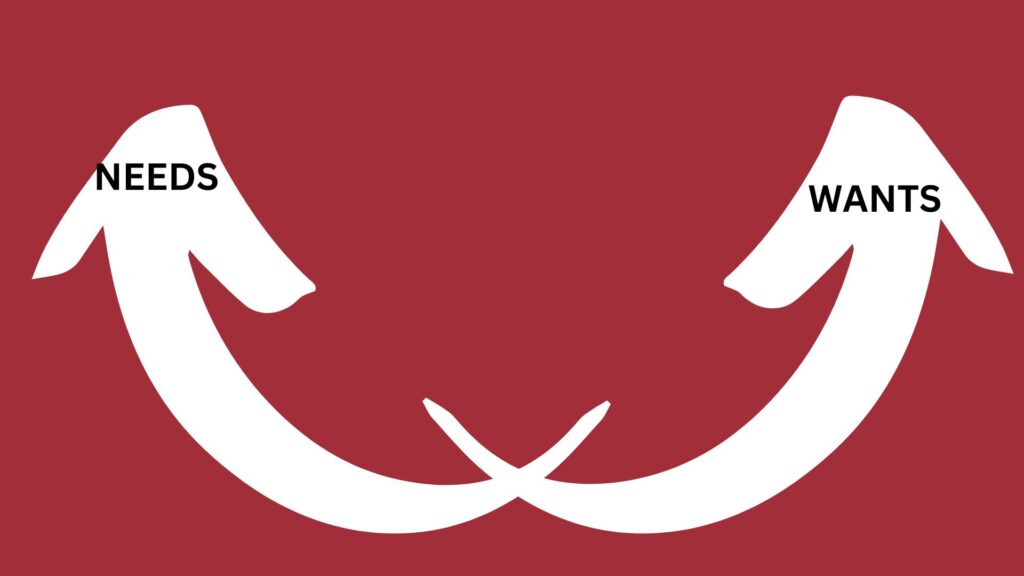Keep your needs and wants in perspective
“Keeping your needs and wants in perspective” is a fundamental aspect of personal finance. In financial planning, defining the boundary between these two categories is crucial. Needs, the essentials for survival and well-being, stand distinct from wants, the desires that enhance our lifestyle. This differentiation forms the bedrock of sound financial planning. In this exploration, we dive into the significance of discerning needs and wants, emphasizing how to be a supersaver and to =set goals= We also recognize the value of considering a =part-time job or side hustle= to enhance our financial journey. Let’s embark on a trip to align our financial priorities, ensuring our needs are met without compromising our long-term goals.
Keep your needs and wants in perspective.
Embarking on the financial terrain with a clear perspective on your needs and wants is like having a reliable compass guiding you in the right direction. This understanding becomes particularly crucial during the development process of your financial plan. By distinguishing between essential needs and discretionary wants, you lay the foundation for informed decision-making, ensuring that your financial resources are directed toward what truly matters.
Identifying Your Needs
A fundamental step toward financial well-being in personal finance involves identifying and prioritizing your needs. Establishing clear criteria for recognizing these needs is the first key. From the essentials of housing and food to healthcare and transportation, pinpointing everyday needs forms the basis of sound financial planning. Once identified, the challenge lies in prioritizing these needs within the confines of a budget. In this exploration, we’ll delve into the criteria for recognizing needs, provide examples of everyday needs, and offer practical tips for prioritizing them in your budget.
Recognizing Your Wants
It’s essential to unravel what indeed constitutes a want. From luxury items that elevate our lifestyle to entertainment and dining out, these typical wants add an extra layer of enjoyment to our lives. By delving into the characteristics and examples of desires, we gain valuable insights into how these elements fit into our financial landscape. Recognizing our wants is pivotal in aligning our spending with our financial goals and maintaining a healthy balance between indulgence and financial responsibility.
Balancing Needs and Wants
Achieving financial equilibrium involves a delicate balance between needs and wants, and practical strategies are crucial in finding that balance. Two key strategies are budgeting and mindful spending. One widely adopted approach is the 50/30/20 rule, a thumb rule for budgeting that provides a structured framework. According to this rule, 50 percent of your income should designated to your needs, ensuring essential expenses are covered. The following 30 percent is allocated to your wants, offering room for discretionary spending on things like a dream vacation, debt repayment, or wedding planning. The remaining 20 percent is designated for savings and debt repayment, fortifying your financial foundation. Striking a healthy balance requires careful consideration, ensuring your needs are at most 50 percent of your income and allowing you to save for both necessities and wish-list items within the 30 percent allocation. It’s a road map to harmonizing your financial priorities and achieving a well-rounded approach to your financial journey.
Striking a balance between immediate desires and long-term aspirations is pivotal in financial planning, encapsulating the essence of “Keep your needs and wants in perspective.” Saving is a safety net for impending needs, ensuring you have the financial means for upcoming desires. Simultaneously, investing becomes a strategic tool for realizing enduring goals, providing a pathway for sustained financial growth. This dual approach allows you to navigate short-term wants and long-term financial security with foresight and efficiency.
Practical Tips for Keeping Perspective
Maintaining a balanced perspective in personal finance involves practical strategies. Firstly, set clear financial goals, providing direction and purpose to your financial journey. Consistently tracking expenses is crucial, offering insight into spending patterns and areas for improvement. Additionally, differentiate between short-term satisfaction and long-term benefits, ensuring that your financial decisions align with your overarching objectives. These practical tips empower you to navigate the financial landscape with clarity and purpose.
Overcoming Challenges
Navigating the financial landscape isn’t without challenges, but overcoming them is essential for financial well-being. Peer pressure and societal influences often lead to financial decisions that may not align with your goals. Resisting the urge to “keep up with the Joneses” and making wise spending choices are crucial in maintaining financial integrity. Financial stress, a common challenge, can be minimized through frugal living and prudent financial management. However, seeking professional advice is wise when faced with complex financial questions. Tax laws and retirement plans can be intricate and confusing. Consulting with a financial professional ensures you make informed decisions aligned with your financial objectives.
Conclusion
The enduring rewards of maintaining a clear perspective on needs and wants, encapsulated in the phrase “Keep your needs and wants in perspective,” are profound for achieving financial stability and cultivating peace of mind. By discerning between necessities and desires, adopting practical budgeting strategies, and embracing the balance between short-term satisfaction and long-term goals, you pave the way for a secure and harmonious financial future.

